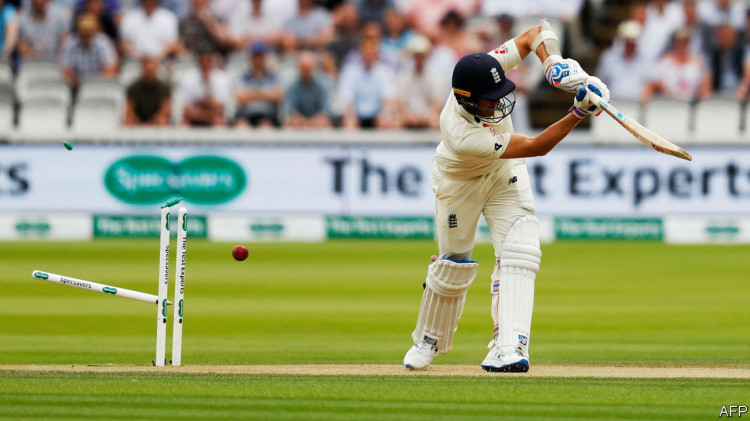Cricket is now a day's konw by everyone but very few one knows about cricket history From where it's come and how it's evolved
History of cricket; history beginning in the late 16th century. Having originated in south-east England, it became the country's national sport in the 18th century and has developed globally in the 19th and 20th centuries. International matches have been played since 1844 and test cricket began, retrospectively recognised, in 1877.
Origin of cricket ;
There is consensus of expert opinion that cricket was probably created during Saxon or Norman times by children living in the weald, an area of dense woodlands and clearings in south-east England that lies across Kent and Sussex
The first definite reference is dated Monday, 17 January 1597 (old style Julian date, the year equating to 1598 in the modern calendar).
There have been several speculations about the game's origins including some that it was created in France or Flanders. The earliest of these speculative references is dated Thursday, 10 March 1300 and concerns the future king Edward II playing at creag and other games in both Westminster & Newland has been suggested that creag was an Olde English word for cricket but expert opinion is that it was an early spelling of “craic” meaning "fun and games in general.
It is generally believed that cricket survived as a children's game for many generations before it was increasingly taken up by adults around the beginning of the 17th century. Possibly cricket was derived from bowls, assuming bowls is the older sport, by the intervention of a batsman trying to stop the ball from reaching its target by hitting it away. Playing on sheep-grazed land or in clearings, the original implements may have been a matted lump of sheep’s wool (or even a stone or a small lump of wood) as the ball; a stick or a crook or another farm tool as the bat; and a stool or a tree stump or a gate (e.g., a wicket gate) as the wicket.
First definite reference
John Derrick was a pupil at the Royal Grammar school, then the Free School, in Guildford when he and his friends played creckett circa 1550
A 1597 (Old Style - 1598 New Style) court case in England concerning an ownership dispute over a plot of common land in Guildford, surreymentions the game of creckett. A 59-year-old coroner, John Derrick testified that he and his school friends had played creckett on the site fifty years earlier when they attended the free school.Derrick's account proves beyond reasonable doubt that the game was being played in Surrey circa1550, and is the earliest universally accepted reference to the game.
The first reference to cricket being played as an adult sport was in 1611, when two men in Sussex were prosecuted for playing cricket on Sunday instead of going to church.
In the same year, a dictionary defined cricket as a boys' game and this suggests that adult participation was a recent development.
Now it's Time to begain The name of cricket was come into the picture
A number of words are thought to be possible sources for the term "cricket". In the earliest definite reference, it was spelled creckett. The name may have been derived from the middle Dutch krick(-e), meaning a stick; or the old English cricc or cryce meaning a crutch or staff, or the French word criquet meaning a wooden post.
The Middle Dutch word krickstoel means a long low stool used for kneeling in church; this resembled the long low wickets with two stmpus used in early cricket.
According to Heiner Gillmeister, a European language expert of the University of Bonna "cricket" derives from the Middle Dutch phrase for hockey, met de (krik ket)sen (i.e., "with the stick chase").
It is more likely that the terminology of cricket was based on words in use in south-east England at the time and, given trade connections with the county of Flanders , especially in the 15th century when it belonged to the duchy's of burgundy, many Middle Dutch. words found their way into southern English dialects.
Now it's time for Early 17th century of cricket there some thing add in the games of cricket.
number of references occur up to theEnlish civil war and these indicate that cricket had become an adult game contested by parish teams, but there is no evidence of county strength teams at this time. Equally, there is little evidence of the rampant gambling that characterised the game throughout the 18th century. It is generally believed, therefore, that village cricket had developed by the middle of the 17th century but that county cricket had not and that investment in the game had not begun. In Early 18th century. Cricket moves out of England.Cricket was introduced to North America via the English colonies in the 17th century,probably before it had even reached the north of England. In the 18th century it arrived in other parts of the globe. It was introduced to the West Indies by colonists and to India by British East compnay mariners in the first half of the century. It arrived in Australia almost as soon as colonisation began in 1788. New Zealand and South Africa followed in the early years of the 19th century.
Cricket never caught on in canda, despite efforts by an imperial-minded elite to promote the game as a way of identifying with the British empire. Canda , unlike Australia and the West Indies, witnessed a continual decline in the popularity of the game during 1860–1960. Linked to upper class British-Canadian elites, the game never became popular with the general public. In the summer season it had to compete with Baseball.During the First World War, Canadian units stationed in Britain played baseball, not cricket. Some development in cricket rules,
The basic rules of cricket such as bat and ball, the wicket, pitch dimensions, overs, how out, etc. have existed since time immemorial. In 1728, the Duke of Richmond and Alan Brodick drew up Article of agreement to determine the code of practice in a particular game and this became a common feature, especially around payment of stake money and distributing the winnings given the importance of gambling.
In 1744, the laws of cricket were codified for the first time and then amended in 1774, when innovations such as lbw, middle stump and maximum bat width were added. These laws stated that the principals shall choose from amongst the gentlemen present two umpires who shall absolutely decide all disputes. The codes were drawn up by the so-called "Star and Garter Club" whose members ultimately founded MCC at LORD'S in 1787. MCC immediately became the custodian of the Laws and has made periodic revisions and recodifications subsequently.now cricket are moved towards England the growth of cricket totally in England England and, in 1751, Yorkshire is first mentioned as a venue.
The original form of Ballwing (i.e., rolling the ball along the ground as in bowls) was superseded sometime after 1760 when bowlers began to pitch the ball and study variations in line, length and pace.
Scorecards began to be kept on a regular basis from 1772 and since then an increasingly clear picture has emerged of the sport's development.
An artwork depicting the history of the cricket bat
The first famous clubs were londan and Datfrod in the early 18th century. London played its matches on the artrillia ground ,which still exists. Others followed, particularly slindon in Sussex which was backed by the Duke of Richmond and featured the star player Richard newland . There were other prominent clubs at Maidenhead, Hornchurch, Maidstone, Sevenoaks.
But far and away the most famous of the early clubs was heambledon in Hampshire. It started as a parish organisation that first achieved prominence in 1756. The club itself was founded in the 1760s and was well patronised to the extent that it was the focal point of the game for about thirty years until the formation of MCC and the opening of LORD'S cricket ground in 1787. Hambledon produced several outstanding players including the master batsman jhon small and the first great fast bowler Thomas brette. Their most notable opponent was the Chertsey and Surrey bowler Edward who is believed to have been the main proponent of the flighted delivery.
It was in answer to the flighted, or pitched, delivery that the straight bat was introduced. The old "hockey stick" style of bat was only really effective against the ball being trundled or skimmed along the ground.
Cricket and crisis
A Game of Cricket at The Royal Academy Club in Marylebone Fields, now Regent's Park, depiction by unknown artist, c. 1790-1799
Cricket faced its first real crisis during the 18th century when major matches virtually ceased during the seven years wars. This was largely due to shortage of players and lack of investment. But the game survived and the "Hambledon Era" proper began in the mid-1760s.
Cricket faced another major crisis at the beginning of the 19th century when a cessation of major matches occurred during the culminating period of the Napoloice wars. Again, the causes were shortage of players and lack of investment.
But, as in the 1760s, the game survived and a slow recovery began in 1815.
On 17 June 1815, on the eve of the Battle of Waterloo British soldiers played a cricket match in the Bois de la Cambre park in Brussels. Ever since the park area where that match took place has been called La Pelouse des Anglais (the Englishmen's lawn).
MCC was itself the centre of controversy in the Regency period, largely on account of the enmity between Lord fredicrick Beauclerk and George osbaldeston. In 1817, their intrigues and jealousies exploded into a match-fixing scandal with the top player William lembert being banned from playing at LORD'S cricket ground life. Gambling scandals in cricket have been going on since the 17th century.
In the 1820s, cricket faced a major crisis of its own making as the campaign to allow roundarm balling gathered pace.now it's Time for 19th century of cricket world,
The game also underwent a fundamental change of organisation with the formation for the first time of county clubs. All the modern county clubs, starting with suxess in 1839, were founded during the 19th century. No sooner had the first county clubs established themselves than they faced what amounted to "player action" as William clarke created the travelling All England Elvene in 1846. Though a commercial venture, this team did much to popularise the game in districts which had never previously been visited by high-class cricketers. Other similar teams were created and this vogue lasted for about thirty years. But the counties and MCC prevailed.
A cricket match at Darnall, Sheffield in the 1820s.
The growth of cricket in the mid and late 19th century was assisted by the development of the railway network. For the first time, teams from a long distance apart could play one other without a prohibitively time-consuming journey. Spectators could travel longer distances to matches, increasing the size of crowds. Now , the International cricket beging,The first ever international cricket game was between the USA and CANADA in 1844. The match was played at the grounds of the st George's cricket club in New York.
The English team 1859 on their way to the USA
In 1859, a team of leading English professionals set off to North America on the first-ever overseas tour and, in 1862, the first English team toured Australia. Between May and October 1868, a team of Austrailina Aborigines toured England in what was the first Australina cricket to travel overseas.
The first Australian touring team (1878) pictured at Niagara Falls
In 1877, an England touring team in Australia played two matches against full Australian XIs that are now regarded as the inaugural test matches. The following year, the Australians toured England for the first time and the success of this tour ensured a popular demand for similar ventures in future. No Tests were played in 1878 but more soon followed and, at THE OVLE in 1882, the Australian victory in a tense finish gave rise to The Ashes.
South Africa became the third Test nation in 1889.
It's Time for county cricket , National championships ,A significant development in domestic cricket occurred in 1890 when the official county championship was constituted in England. This organisational initiative has been repeated in other countries. Australia established the sheffield shield in 1892–93. Other national competitions to be established were the Currie Cup in South Africa, the Plunkett Shield in New Zealand and the Ranji Trophy in India.
Now some point on how much Ball per over ?
Balls per over
Cricket started with four balls per over. In 1889 the immemorial four ball over was replaced by a five ball over and then this was changed to the current six balls an over in 1900. Subsequently, some countries experimented with eight balls an over. In 1922, the number of balls per over was changed from six to eight in Australia only. In 1924 the eight ball over was extended to New Zealand and in 1937 to South Africa. In England, the eight ball over was adopted experimentally for the 1939 season; the intention was to continue the experiment in 1940, but first-class cricket was suspended for the Second World War and when it resumed, English cricket reverted to the six ball over. The 1947 Laws of Cricket allowed six or eight balls depending on the conditions of play. Since the 1979/80 Australian and New Zealand seasons, the six ball over has been used worldwide and the most recent version of the Laws in 2000 only permits six ball overs.
Now the Time for talk on 20th century of cricket ,
Growth of Test cricket
Sid barnes traps lala amarnath lbw in the first official Test between Australia and India at the MCG in 1948
When the Imperical cricket conference (as it was originally called) was founded in 1909, only England, Australia and South Africa were members. West Indies(1928), New Zealand(1930) and India (1932) became Test nations before the Second World War and Pakistan(1952) soon afterwards. The international game grew with several ICC Affiliate Members being appointed and, in the last quarter of the 20th century, three of those became full members: srilanka (1982), Zimbabwe (1992) and Bangladesh(2000). They were followed in the early 21st century by Ireland and Afghanistan (both 2018).the test cricket always high rated but some bad things happen in crickte like,
Suspension of South Africa (1970–91) cricket team , Which very bad things for cricket world and also for South Africa.
21st century cricket of cricket
In June 2001, the ICC introduced a "Test Championship Table" and, in October 2002, a "One-day International Championship Table". As indicated by ICC rankings,
the various cricket formats have continued to be a major competitive sport in most former British Empire countries, notably the Indian subcontinent, and new participants including the Netherlands. In 2017, the number of countries with full ICC membership was increased to twelve by the addition of Afghanistan and Ireland.
The ICC expanded its development programme, aiming to produce more national teams capable of competing at the various formats. Development efforts are focused on African and Asian nations, and on the United States. In 2004, the ICC international cup brought first-class cricket to 12 nations, mostly for the first time. Cricket's newest innovation is twenty 20, essentially an evening entertainment. It has so far enjoyed enormous popularity and has attracted large attendances at matches as well as good TV audience ratings. The ICC twenty20 internatinal cup tournament was held in 2007. The formation of Twenty20 leagues in India – the unofficial Indian cricket league , which started in 2007, and the official indian premiere league , starting in 2008 – raised much speculation in the cricketing press about their effect on the future of cricket.BIG Bash twenty20 league, PCL ( Pakistan cricket league twenty 20) , Bangladesh cricket league twenty20, name as ( BPL) , West Indies cricket league twenty 20 names as ( CPL ) , Netwest twenty20 league, this is famous crickte league play by cricket world . Cricket is evolved from zeor to 100 it's take so much year but right now cricket is very famous games for every one they love to watch the games so it's all about cricket.






